Platform Giants and Venture-Backed Startups Analysis
UPDATE: A quick note of clarity, since many readers are misinterpreting (ie, not fully reading) the analysis done here. I urge people to read the Conclusion, where I talk at length about the intentional narrowness of this post and the many important questions remaining. My main objective was to call into question a report that says the major tech giants have no impact on venture capital markets, and using data to quickly demonstrate why that's wrong. I'm making no statements about broader impacts-such as the movement of VC into adjacent areas or non-tech portions of VC, nor the impact of tech giant dominance on innovation. I note these issues clearly in the conclusion.
A friend recently pointed me to a July study by Oliver Wyman titled Assessing the Impact of Big Tech on Venture Investment. I was immediately intrigued because this is a question I'm asked all the time and one for which I don't have a good answer. On the one hand, I see how platform giants could expand startup activity because they seed an ecosystem, improve labor quality, and provide capital (as customers, investors, and acquirers). On the other hand, I see how their sheer dominance-and the ability to leverage their power into adjacent markets by favoring their own content or wares-makes it difficult to compete in their space. In fact, reporters have told me that most VCs won't touch startups operating anywhere near these companies' orbits, a phenomenon that is apparently so common it's been given a nickname: "kill-zones".
What's really going on?
The Oliver Wyman report comes down firmly on the side of Big Tech (note: the study was funded by Facebook, though that alone doesn't disqualify it in my mind). Here's the summary slide from the report, which presents their overall findings of the impact that Facebook, Google and Amazon ("FGA") have on activity in the venture capital market.
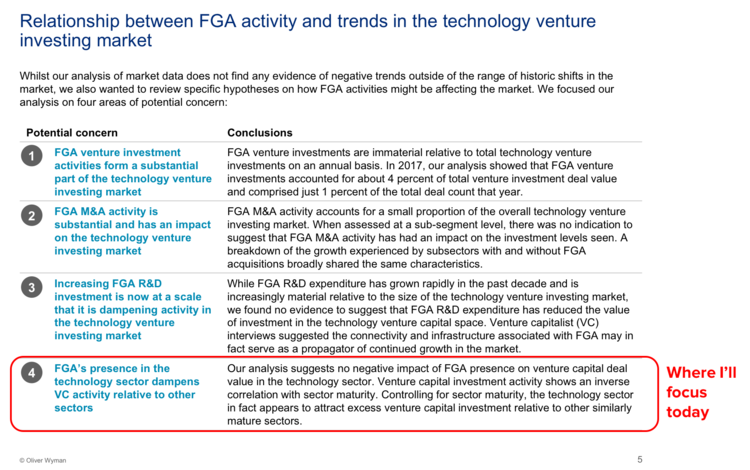
The fourth finding jumped off the page at me: the presence of FGA has no negative impact on the venture capital market in these areas. Really? None at all? That seems suspicious, and as the simple analysis I present below will show, my initial skepticism is for good reason.
To be clear, my analysis won't get us to a complete understanding of the enormity of this issue-this is just a simple blog post done on a Friday afternoon. However, it does credibly call into question the validity of the Oliver Wyman analysis that concludes "nothing to see here", by easily blowing a pretty big hole through that fourth point.
Oliver Wyman's Flawed Analysis
To support their argument, the authors demonstrate that venture investments in the "technology" sector are outperforming peer groups, or at worst, are within the historical range. But even this argument is suspect, because as shown by the second chart, compound annual growth rates ("CAGR") on investments in technology startups since 2015 (minus 21 percent) are woefully behind growth in other sectors (minus 5 percent).
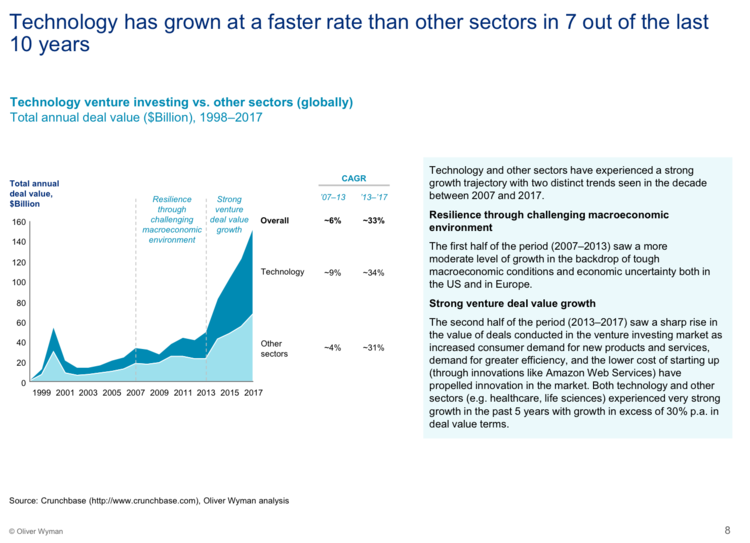

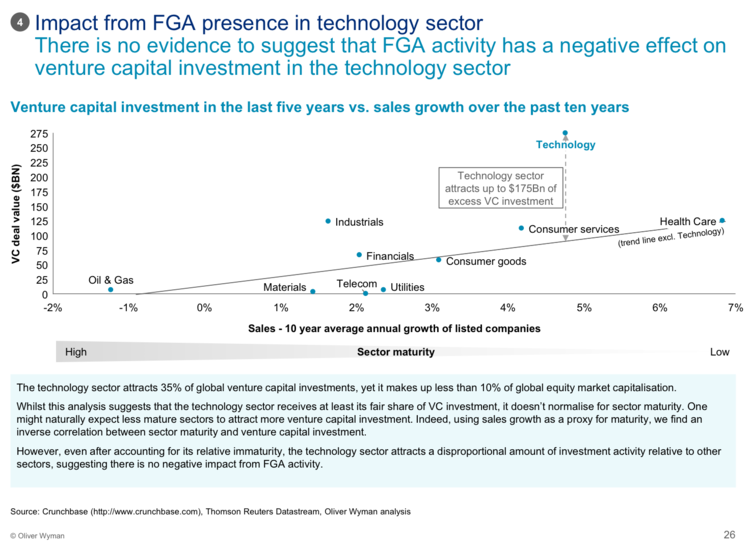
Putting that aside, here's what jumped out at me from the report buried in the details of their methodology (page 28):
Crunchbase [the venture data source used in the Oliver Wyman report] does not have a mutually exclusive industry sector and subsector categorisation. Instead it has roughly 300 industry categories and investments can be assigned to multiple categories. In defining the "Technology" sector within the Crunchbase venture investing market data, we reviewed each of the category fields contained in the data set to determine whether to include or exclude that category from our technology sector definition. We considered 53 of these to fall within the technology sector for the purposes of this analysis. Companies that did not fall in one of these subsectors were assigned to "other". This necessarily creates the broadest definition of what constitutes a technology startup and one that is suitable for the exercise of understanding trends in the broader technology venture investing market. [emphasis added]
Hang on a second there. If you have the ability to examine industries on a detailed basis, why would you intentionally choose not to? Why would you intentionally aggregate those detailed industries to understand "trends in the broader technology venture investing market"? Aren't the detailed industry/product markets what matter the most here?
Investors and entrepreneurs don't at all think in such broad terms as the Oliver Wyman study suggests, which is precisely the problem. That got me to thinking: what do the data say when looking at more detailed industries?
As it turns out, the decision to aggregate industries at a high level produces an entirely different result than if the disaggregated (detailed) industry categorizations had been maintained. And that presents a major challenge to the validity of the study's results.
A Roadmap for Detailed Industry Analysis
To get at the issue of the impact of FGA on venture investing, I did a few things with data from the PitchBook venture capital database. For starters, I focused my analysis on "first financings," which is the initial round of equity capital invested in a startup. This early stage of a startup's life is exactly the decision point when an investor would be deciding whether a company is playing in an FGA sandbox, or similarly, when an entrepreneur would be receiving that feedback. These early-stage deals can also be thought of as startups entering the venture-backed pipeline, and a marker for a particular market segment's expected future growth.
Second, I looked at annual first financing activity at the level of detailed industries-the most detailed possible, in fact, on the PitchBook database-and in particular those financings that are most directly related to the FGA companies. I aggregated data by primary industry only, so that I could capture companies most similar to the core function of each FGA company (as opposed to scooping up companies that are only secondarily engaged in similar activities).
The image below demonstrates the industry structure in the PitchBook database, and the primary industry assigned to each FGA company in context.
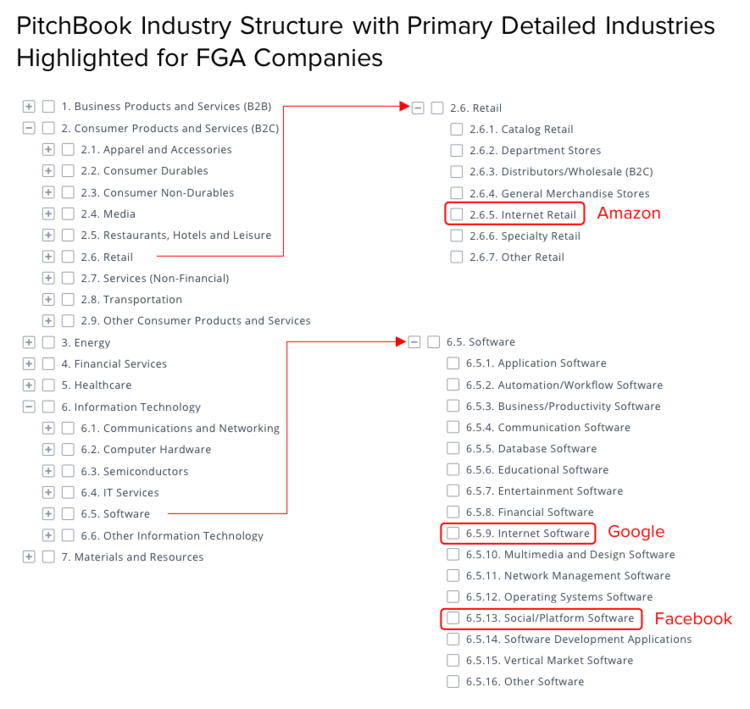
Notice the Information Technology sector in the leftmost (least granular) sector column. This is the most consistent with the "technology" sector in the Oliver Wyman report. But here, I'll drill down further-not just distinguishing the Software sub-sector from others in the Information Technology sector, but within Software itself, distinguishing among 16 different detailed industries. Amazon is assigned to the Internet Retail industry, which is contained in the Retail sub-sector of Consumer Products and Services (B2C) sector.
With that backdrop in place, what do the data say?
VC First Financings by FGA Primary Industry
Let's start with Internet Software (Google's primary industry in the PitchBook database). The first chart shows changes in time of the number of venture capital first financings occurring each year, compared with a set of comparables-the remainder of the Software sub-sector ("Rest of Software"), the non-software portion of the Information Technology sector ("Rest of IT"), and the non-IT portion of total venture capital ("Rest of VC").
To compare across these different-sized universes of companies, each year of data is indexed in comparison to 2007 (which equals one). The idea here is to show how the annual level of first financings in each segment is changing over time relative to the others in percentage terms.
The first chart shows that after outpacing the Rest of Software until 2011, the number of startups entering the venture-backed pipeline in the Internet Software industry goes into a steep and permanent decline. It was even outperformed by the Rest of IT by 2015.
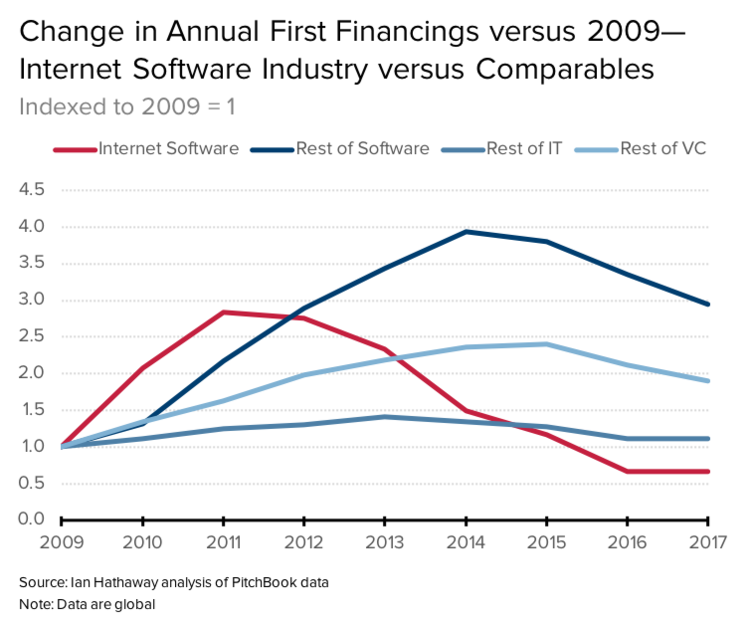
Another way to look at this is showing percent changes over various time periods (annualized to allow the comparison of periods of different lengths). This is akin to what economists call a basic "difference-in-differences" analysis. The Oliver Wyman report stresses the last five years (2012 to 2017) and the last two years (2015 to 2017), so I'll use those periods too. I'll also add a third (2009 to 2017), which marks the beginning of the boom cycle in venture capital following the Great Recession.
Demonstrating these data points for Internet Software and its comparables reveals that the startup pipeline in the industry grew more slowly (or contracted more sharply) than did its comparables during each time period. Since 2015, first financings in industries directly exposed to Google's core activities declined by nearly 25 percent each year (as it also did since 2012), while the Rest of Software and the Rest of IT declined by only twelve percent and six percent each year, respectively.
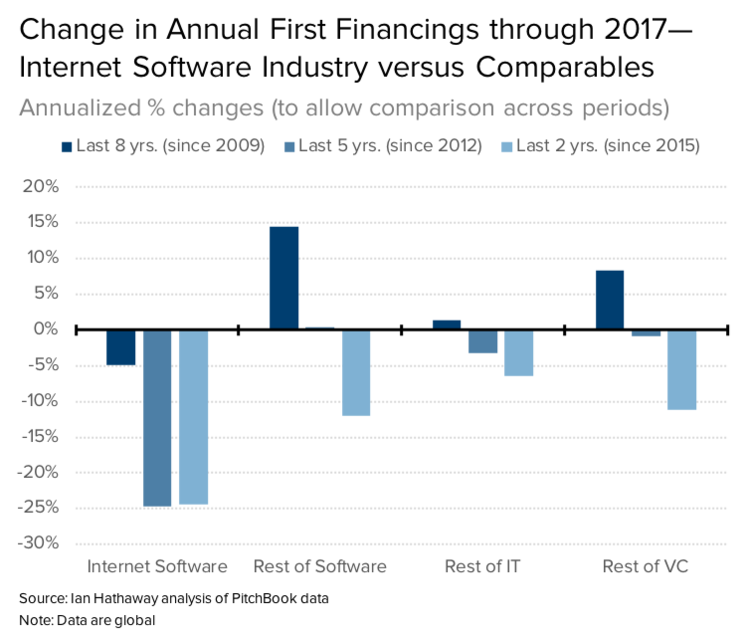
The next two sets of charts perform the same exercises as above for the Social/Platform Software industry (Facebook's primary industry in the PitchBook database) and for the Internet Retail industry (Amazon's primary industry in the PitchBook database).
Though the shapes of these respective series are different-they expand and contract at different intervals and at different paces-the overall story is the same. In both instances, the expansion of venture capital first financings grew more slowly or contracted more rapidly in each detailed FGA industry than it did for comparable sub-sectors (Software, Retail), sectors (IT, B2C), and for the rest of venture capital as a whole.
This is true in every such case in the bar charts below during the last five years (there are some exceptions over the eight-year period). The message is clear-the number of companies entering the venture-backed pipeline in industries that are in direct competition with core FGA activities have been on a steady and persistent decline that exceeds comparable groups. This is true across several time periods and geographies (the data shown here are global, but when broken out between the United States and Rest of the World, the overall trends are the same).
Such evidence is consistent with the hypothesis that VCs are unwilling to fund new businesses in this space, or that entrepreneurs are not willing to bring forward new business ideas in this space, or both.
As the first chart shows, growth in Social/Platform Software first financings was strong from 2009 to 2014, before contracting sharply in the years after. By the end of the period, annual first financings in the detailed industry were more subdued compared with the beginning of the period than it was for the rest of Software, and about the same as it was for the rest of venture capital first financings overall.

As the second chart shows, since 2015, first financings in industries exposed to Facebook's core activities (the Social/Platform Software industry) declined by over 25 percent annually, whereas Rest of Software and Rest of IT declined by only eight and six percent, respectively. When looking over a long time periods, either over the last five years or last eight years, the results are directionally the same-the number of new companies entering the venture-backed pipeline in the Social/Platform Software industries declined at a pace far in excess of these comparables.
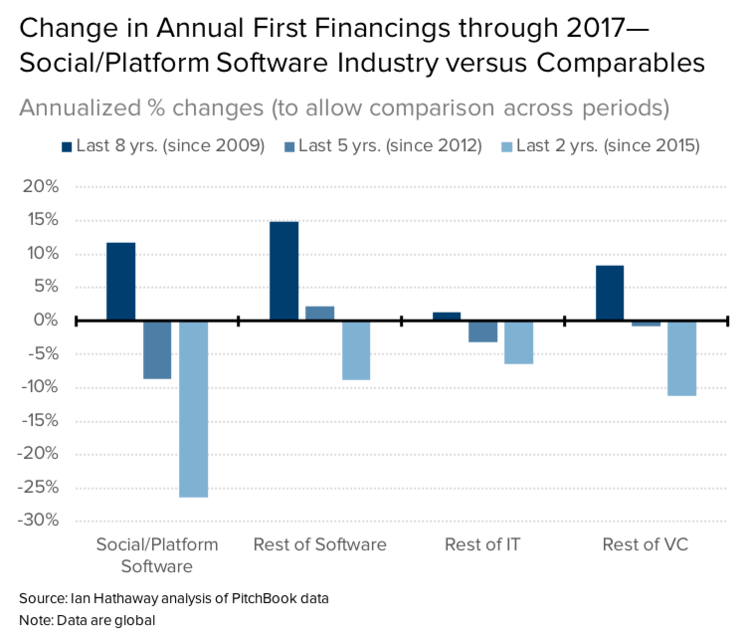
Moving to Internet Retail, In the first chart, we see growth in annual Internet Retail first financings that is far in excess of any comparable-the Rest of Retail sub-sector, Rest of B2C sector, or Rest of VC as a whole-until 2015, after which things take a steep nosedive. In fact, by the end of the period, the expansion of venture capital first financings in Internet Retail was less than for B2C and venture capital as a whole (but was about the same at the remainder of Retail).
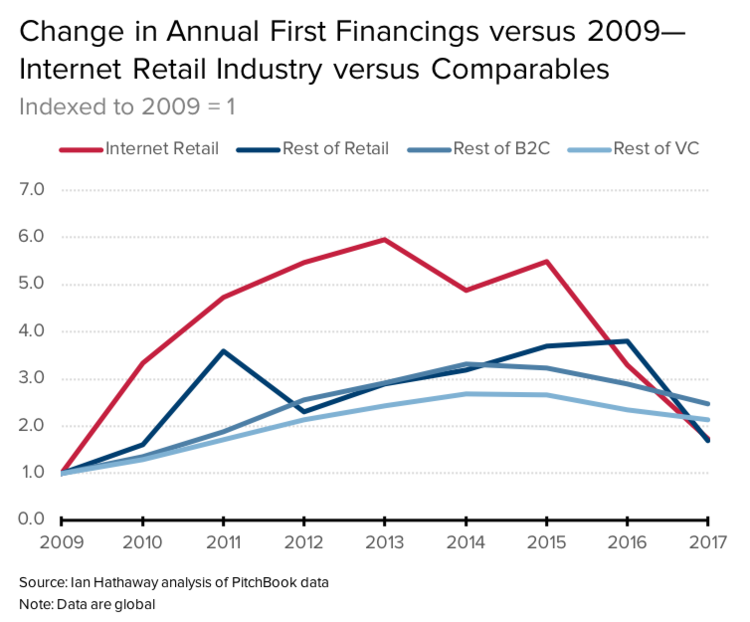
In more recent years, as the second chart shows, since 2015, first financings in industries exposed to Amazon's core activities declined by over 40 percent on an annualized basis, whereas the Rest of Retail and the rest of B2C declined by 31 and 11 percent each year on average, respectively.
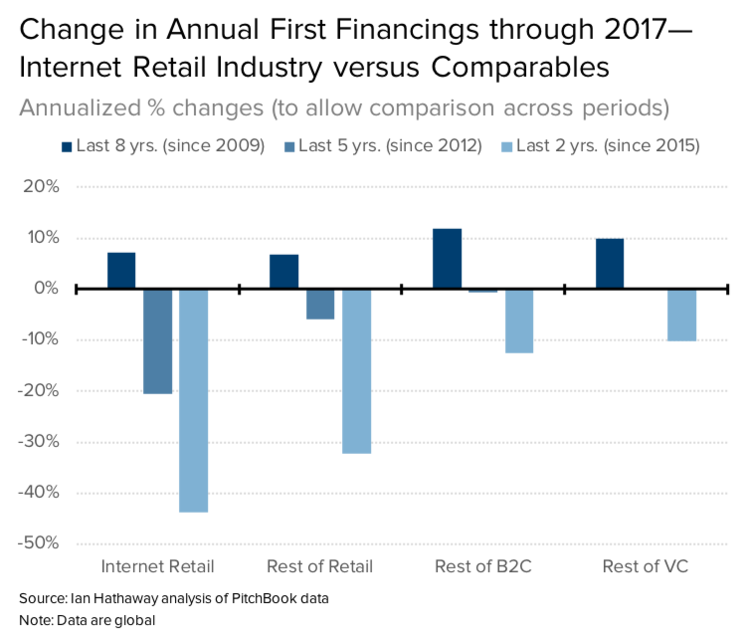
Conclusion
So, what have we learned today?
To start, it's clear-especially in the most recent years-that the detailed industries with a primary FGA presence are witnessing a remarkable contraction in companies entering the venture-backed pipeline. So, what does this all mean?
At minimum, it's a rebuke of Oliver Wyman's claim that there is "no evidence" of a negative impact on venture investment in "technology" due to the presence (or conduct) of FGA platforms. I would say there is at least "some evidence" to that effect and that's probably an overly conservative stance. The Oliver Wyman study is flawed because it grouped all "technology" activities together, and so doing, obscured the underlying deterioration of new company activities in core FGA sectors. Instead, the numbers were being driven by growth in other areas of information technology.
Questioning the Oliver Wyman study is one thing; it's quite another to get clarity on the lingering question I've had about the impact that technology giants are having on venture-backed startups more broadly. Unfortunately, that lack of clarity remains. Improving on that requires much deeper research than I've done today. But, it does better clarify some questions.
A number of factors outside of market power could explain the decline of new startup activity in FGA industries. Even if market power (or the leveraging of that power into adjacent markets) is to blame, that doesn't automatically spell trouble for innovation-and in markets with strong network effects, strong concentration might be the most likely or even preferred outcome. In addition, venture capital investment may have increased in non-tech sectors too, so that the tech giants have simply diverted the flow of capital to other areas.
And to be transparent, my analysis here is not without important limits. For example, it doesn't take a look at adjacent industries that are reliant upon access to these very platforms-that's a major question for antitrust authorities, but one that goes well outside the scope of what I wanted to accomplish here briefly today. It's also worth nothing that even the most detailed industries available in the PitchBook database are still too coarse for a precision analysis of the impacts of FGA companies on venture-backed startups in those spaces. To do that, one would need to build competitor lists from the bottom up, by going into the details of what individual companies do. That task will have to be for another day.
Having said that, the data are suggestive, and the magnitude of declines in startup activity in FGA industries surprised me. It's something that I'd like to pay more attention to, and I hope that other researchers are looking into this dynamic, particularly as these companies move into adjacent markets. For now, I hope that I've at least demonstrated the need for deeper analysis into these trends-and to question reports that conclude there's nothing to see here.
source: here